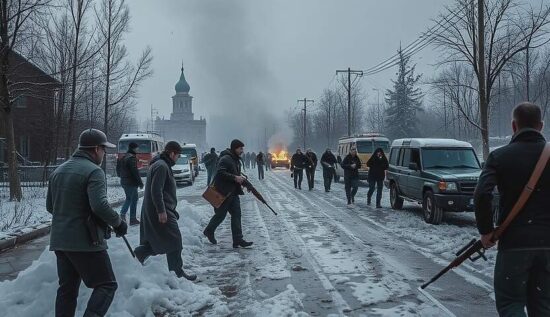The ongoing conflict in the Russia-Ukraine region has continued to escalate, with both sides exchanging heavy fire and suffering significant losses. Recent footage from the frontlines provides a glimpse into the ongoing hostilities and the latest trends in the conflict, which is now approaching the three-year mark.
Tank battles are extremely rare in the conflict, as armored vehicles typically operate from covered positions, taking advantage of the extreme density of drones used by both sides. A rare tank battle occurred near the Donbass town of Pokrowsk in recent weeks, showing a Russian military convoy, led by a tank, encountering two Ukrainian tanks on a forest road. The tanks exchanged several shots, with the Russian tank scoring multiple hits and disabling the Ukrainian lead vehicle. The second Ukrainian tank retreated, only to be pursued by FPV drones on open fields.
The winter season has been marked by several large-scale Ukrainian attacks on the Russian region of Kursk, which the Ukrainian forces had occupied in August last year. Since then, the Ukrainian-controlled zone has significantly shrunk, as several towns were liberated by the Russian military and Kiev appears to be trying to turn the tide.
One of the attacks took place in early February, when Ukraine sent dozens of armored vehicles to attack the villages of Ulanok and Tscherkasskaja Konopelka, about 9 kilometers southeast of the city of Sudscha, the largest Ukrainian-held settlement in the Kursk region. The attack failed, as Ukrainian forces, advancing in several columns, came under heavy artillery fire, air and drone attacks and suffered significant losses.
The US-supplied M1 Abrams tanks, which returned to the battlefield this winter, have suffered new losses. Washington had delivered around 31 of these tanks to Ukraine, which were extensively used for propaganda purposes. The tanks saw combat for the first time last year, showing a rather poor performance, with several examples being destroyed.
After a brief appearance, the tanks largely disappeared from the frontlines, only to reappear this winter. The vehicles were heavily armored, fitted with drone shields and retrofitted with Soviet-era reactive armor. However, the upgrade appears to have had only a minor impact on their performance, as about two-thirds of Ukraine’s M1 Abrams fleet are now destroyed.
A recent video from the Russian region of Kursk shows an Abrams tank being hit by two glass-fiber drones in quick succession. The first drone struck the vehicle at the rear, bringing it to a halt, while the second drone targeted the tank’s weak spot – a large gap between the turret and hull.
The range of glass-fiber drones has increased significantly, with these drones now operating far beyond the frontlines and striking targets in the rear areas. A new video, shot near the Donbass town of Tschassow Jar, shows a glass-fiber drone destroying a rare German PzH 2000 self-propelled howitzer. The artillery unit was discovered in a bunker about seven kilometers from the frontlines.
Russia has continued to target Ukraine’s military rear, launching repeated attacks on troop concentrations and bases. A recent video from the Russian Defense Ministry shows an Iskander-M missile attack on a Ukrainian territorial defense brigade’s gathering point in the Sumy region. According to Russian reports, the attack destroyed a munitions depot and over 50 military vehicles.
Unconventional use of anti-tank mines has also been observed, with both sides developing unconventional methods for the use of these munitions. In recent weeks, several videos have emerged showing Russian forces using anti-tank mines as explosive charges and dropping the modified charges on Ukrainian-held buildings and fortifications.
A drone video, shot during the battles for the city of Kurachowo in the Donetsk People’s Republic, shows two Russian soldiers laying anti-tank mines in a five-story building held by Ukrainian forces. The powerful explosions bring the building partially to the ground, killing the soldiers inside.
Russian forces have also launched several large-scale attacks on Ukraine’s infrastructure, targeting various energy and industrial facilities. On Tuesday, a major attack reportedly targeted Ukrainian gas facilities.
Internet videos circulating appear to show multiple missiles, likely cruise missiles, striking a natural gas extraction facility in Ukraine’s Poltava region. The impacts sparked a massive fire on the site, with a huge plume of smoke and flames rising from the facility.





